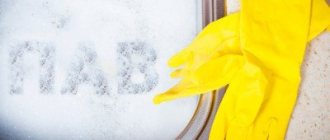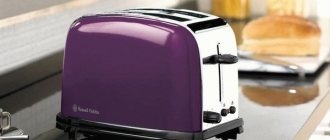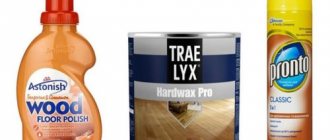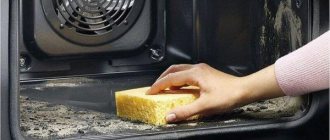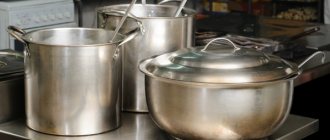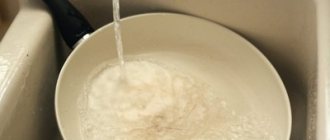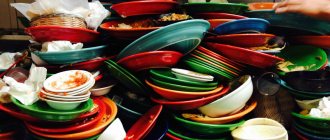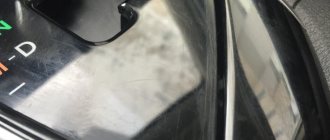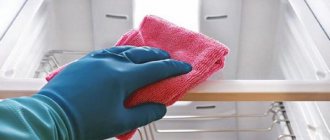Often, when baking waffles on an electric or cast iron waffle iron, housewives are faced with the problem of carbon deposits appearing on its working surfaces. You can clean this deposit from the waffle iron, which spoils the quality of the waffles, using natural remedies that are both effective and harmless.
You cannot clean the device while it is plugged in; first, the waffle iron must be disconnected from the power supply. Then remove the remaining dough with a paper towel.
Only after this they begin to clean the working surfaces and the body. If the device is old, it is cleaned in the same way as cast iron frying pans.
How to clean a cast iron waffle iron
Many housewives still use very practical cast iron waffle irons, which are very easy to use. This design is extremely simple, and consists of two working surfaces fastened together. Baking is done on the stove, heating the device.
The best way to clean a cast iron waffle iron is to soak it in hot, soapy water for a long time. Under the action of soap, all dirt will soften and can be easily removed with a washcloth.
If the soot is very strong, then simply soaking will not solve the problem. Proven home recipes will help.
How to clean an electric waffle iron?
If the plates in a modern waffle iron are removable, then they can be cleaned in the same way as with a cast iron device.
Cleaning electric models with non-stick plates differs significantly from the described procedure for cleaning a cast iron waffle iron.
Important! Under no circumstances should an electrical appliance be immersed in water for cleaning.
How can I clean the waffle iron from carbon deposits in this case? To do this, you can use the following method:
- Disconnect the electrical appliance from the power supply.
- Remove excess grease and food from the pans using a soft sponge or paper towel.
- Oil stains and dry crumbs must be removed using a silicone brush or spatula.
- Oil stains that cannot be cleaned with a spatula or brush should be poured with vegetable oil and left to soak for a few minutes.
- Remove any dirt that has already soaked into the oil using a paper towel.
- Wipe the grooved surface with a damp, rough-textured kitchen towel.
Important! Regularly cleaning your waffle iron after each use is the best way to prevent stubborn residue from forming.
How to remove carbon deposits from a waffle iron with baking soda
Baking soda can be used to very easily clean the surface of a cast iron waffle iron. You just need to soak the device in water for an hour, and then use a washcloth with soda on it to wipe the surfaces.
If there is very strong, long-standing soot, the waffle iron needs to be soaked in a soda solution for several hours. To do this, dissolve 100 g of baking soda in 1 liter of hot water. After soaking in the same solution, wash the device with a washcloth.
How to remove carbon deposits from a waffle iron
Dishes with black carbon deposits are usually subjected to prolonged soaking, boiling or calcination. There is no other way to clean off a thick layer of burnt and grease. But a waffle iron is not a frying pan: not every waffle iron can be put entirely into a pan of boiling water.
If the appliance is designed for making waffles on the stove or has removable parts, soaking the residue in a cleaning solution is the best way to clean it up. Place the utensils in a large container and use one of the recipes:
- Add a pack of soda and a bottle of silicate glue to a pan of water, leave the waffle iron to soak until the dirt softens.
- Rub laundry soap into the water, bring to a boil and reduce heat to low. “Cook” the dishes for several hours until the carbon deposits begin to come off.
Old carbon deposits will not dissolve in water, but will become softer and can be removed with a little physical force. Scraping off dirt with a steel wool or knife is only permissible from the outside. You cannot scratch the inside of the waffle iron; you will have to use a toothbrush to thoroughly clean the grooved surface of dirt.
Cleaning a cast iron waffle iron with vinegar
Vinegar is another effective way to clean a cast iron waffle iron. You need to moisten a sponge in pure vinegar, wipe the surfaces with it, and leave for half an hour.
In case of severe soot, prepare a vinegar solution for soaking. To do this, you need to dissolve 100 ml of vinegar in 1 liter of water. Soaking time 1 hour. Then simply wash the device with a washcloth - all the dirt will come off.
How to clean old oil and grease from a waffle iron
Oily deposits inside the waffle iron can be easily washed off using available means:
| Means | Effect |
| baking soda | softens carbon deposits, acts as an abrasive |
| vinegar | dissolves grease, whitens and deodorizes surfaces |
| mustard powder | degreases, cleans |
As an example, here is a recipe for a paste made from baking soda and hydrogen peroxide:
- Sprinkle the dirty plates generously with baking soda.
- Moisten the powder with hydrogen peroxide.
- Close the lid and let the substance work.
- After an hour, clean the inside of the appliance with a toothbrush.
- Repeat the entire procedure if necessary.
- Wipe the cleaned surface with a damp cloth, then with a dry cloth.
Vinegar or a solution of citric acid is applied to the plates with a sponge, mustard powder is poured and moistened with water. The following steps are similar to cleaning with soda paste.
If it is possible to remove and soak the panels, a solution is prepared from the indicated products in the following proportions per 1 liter of water:
| Means | Quantity |
| soda | 100 g |
| mustard | 100 g |
| vinegar | 100 ml |
| lemon acid | 1 sachet |
Waffle irons with Teflon coating are contraindicated for cleaning with acids and abrasives - the non-stick layer can deteriorate and peel off.
How to clean an electric waffle iron
Cleaning off carbon deposits from an electric waffle iron is just as easy as from a metal one. If the plates can be removed, clean them with the same means as cast iron ones.
Fat deposits on the working surfaces of an electric waffle iron are filled with vegetable oil and left for several hours. After this soaking, you can remove all dirt with a paper towel.
You can bake delicious and rosy waffles only on a perfectly clean waffle iron. Therefore, the device must be kept in perfect order.
How to clean an electric waffle iron
It is advisable to have instructions with the manufacturer's recommendations on hand. But if the memo is lost, follow these rules:
- Electric waffle irons should not be immersed in water; they must be cleaned carefully, avoiding moisture getting into the body.
- Teflon parts must not be rubbed with abrasives or left in water for a long time. Consider the coating of the removable plates: non-stick - do not soak!
A non-dismountable waffle iron is cleaned in the following order:
- Disconnect from the network.
- Sweep away the crumbs with a soft brush.
- Remove stuck dough and oil with a paper towel or sponge.
- Try to remove burnt spots with a silicone spatula.
- Moisten everything that cannot be scraped off generously with vegetable oil.
- After a few minutes, the oil will soften the fatty coating - remove the mass with a paper towel.
- Wipe the surface with a damp kitchen cloth.
The outside of the housing is also washed with a well-wrung out cloth so that water does not penetrate into the electrical unit. Do not plug in the appliance until it is completely dry.
A waffle iron with removable panels is washed a little differently:
- Unplug the device and let it cool.
- Disconnect and remove the plates.
- Wash them with warm water and a soft sponge without adding soap.
- Rinse with clean water.
- Leave to dry or wipe with a towel.
- Insert the completely dry plates into the device.
Removable plates without non-stick coating can be soaked briefly and rubbed with a brush. If the instructions allow, you can put them in the dishwasher.
Caring for your electric waffle iron
Many models of electric waffle irons have non-stick coating on the working surfaces. With proper care of the device, carbon deposits have no chance. Simply, after using the device, sweep away all the crumbs with a soft brush and wipe the warm surface with a paper towel or napkin that absorbs grease. Soften any stuck dough with vegetable oil.
If the working surfaces are removable, cleaning the device is even easier. Remove them, rinse with water, wipe dry and return to their place.
If you do not follow these rules on time, you risk again making yourself a problem with cleaning out old fat. And an electric appliance, unlike an old ordinary waffle iron, cannot be put into water and boiled (I hope this is clear to everyone).
True, you can partially apply a self-made paste from the above-mentioned folk remedies to hard-to-remove areas. Then carefully clean the problem area with a soft brush or cloth.
How to clean the working surface of the device is always indicated in the instruction manual. It is unwise to ignore this important information. After all, there are both general recommendations and specific ones specifically for your waffle iron.
Source
How to clean a cast iron waffle iron?
Despite the fact that the modern market is rich in new models of convenient waffle irons, many housewives continue to use the old, familiar cast-iron products. To clean these types of pans, you need to use the same methods as for cleaning old cast iron pans.
Important! This waffle iron is an extremely simple design consisting of two frying pans fastened together. The baking itself is carried out on a tile on which a cast iron device is laid out.
The best way to clean a waffle iron from carbon deposits is to soak it in warm water for a while. Afterwards, all dirt can be easily removed using a soap solution.
Traditional methods
To remove carbon deposits from a waffle iron, you can use natural and chemical means. However, it is important to understand that chemical preparations, although they quickly bring the device to a clean state, contain potent substances and inorganic acids that are hazardous to health. Therefore, they are not recommended for cleaning products that come into contact with food. This way they can enter the body along with food and negatively affect it from the inside.
An alternative to dangerous drugs are proven folk recipes. Let's look at the main products that can be used for these purposes:
- Baking soda. Easily removes dirt of any complexity, softens grease stains on the surface.
- Table vinegar and citric acid. Eliminates unpleasant odors, greasy deposits, and whitens dark spots.
- Dry mustard powder. Removes stains of any origin and perfectly degreases the surface.
- Natural-based laundry soap and stationery silicate glue. These substances can also help in cleaning the waffle maker.
Use of folk remedies:
- A very popular recipe is to place baking dishes in a vat of water, add a generous handful of baking soda and a bottle or two of silicate glue.
- An excellent result, according to experienced housewives, is obtained by boiling dirty dishes in soapy water. This cleaning method may take several hours, and you will need to turn on the hood or open a window, as an unpleasant heavy odor will be released during cleaning.
Traditional methods of cleaning
For kitchen utensils, including waffle irons, use other environmentally friendly methods for removing carbon deposits. I propose to remember the folk methods that our grandmothers used. Suitable for cleaning dishes from carbon deposits:
- Soda (baking soda or ash) - perfectly cleans and softens any hardening on dishes.
- Vinegar and citric acid - whiten stains, eliminate unpleasant odors, and fight grease.
- Dry mustard – perfectly degreases and cleans the surface of dishes.
- You can also use natural-based laundry soap and stationery (silicate) glue. They are also often components of cleaning products made according to folk recipes.
The following method of getting rid of carbon deposits is widely practiced: take a container large enough to place a waffle iron or other kitchen items that require cleaning from carbon deposits (frying pans, frying pans, baking dishes, etc.) Fill with water to cover all items fully. Add a generous handful of soda and a bottle or two of silicate glue to the water.
There are also recipes that use laundry soap. All this should simmer over low heat. The boiling time depends on the age of the deposits and the thickness of the carbon layer. It may take several hours. During this procedure, turn on the hood or open a window, since when the solution boils, vapors with a heavy, unpleasant odor will be released. I'm sure many people don't like this method anymore.

